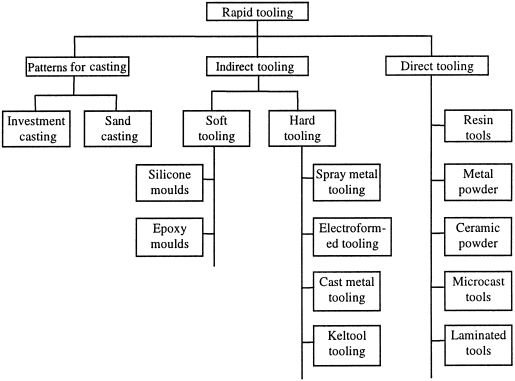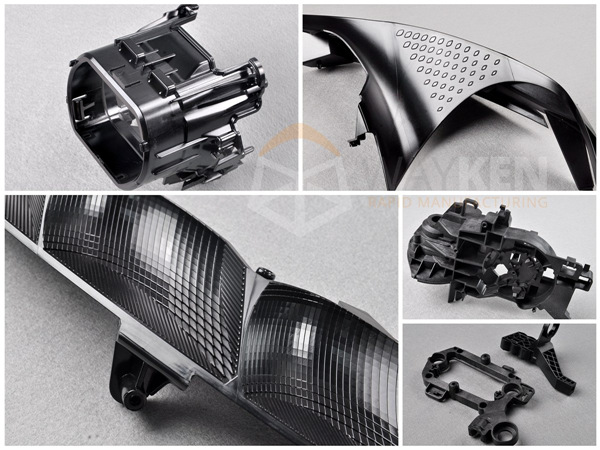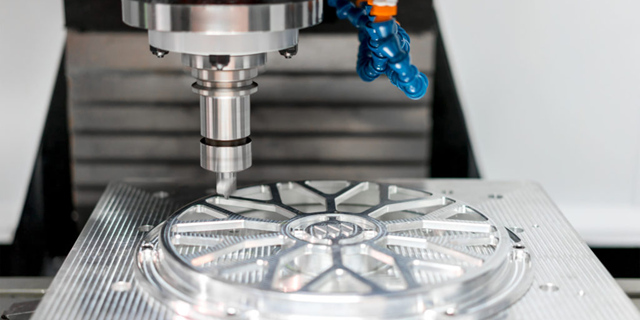Rapid tooling is a technology that allows for the quick production of tools. It involves the combination of techniques for rapid prototyping with conventional or traditional tooling to produce molds quickly. The main reason for the use of rapid tooling is to test parts in the prototyping phase of product development. Prototypes in this context refer to 3D models suitable for testing and evaluating molds, dies, or products. Rapid tooling can be used to produce parts or models from Computer-Aided Design data.
Types of Rapid Tooling

Using rapid tooling, multiple prototypes can be made in a short time. There are two major types of rapid tooling.
Direct Rapid Tooling
In this method, the tools/molds are manufactured directly from the CAD data. The following steps are used in direct rapid tooling;
- A model of the tool or mold is created using Computer-Aided Design software
- The data is sent to a machine (subtractive process, e.g., CNC machine) or a printer (additive process, e.g., 3D printer) for production.
- Direct prototypes are then produced from the molds or tools made. The number of prototypes is generally small.
Indirect Rapid Tooling
This method is more common during prototyping. It is best suitable for experimentation, testing, and evaluation. This is because multiple test molds and tools can be made from one master pattern. The following are the steps used in indirect rapid tooling:
- A model of the master mold is created using CAD software
- The data is sent to a machine or printer to produce the master mold, preferably called pattern.
- More molds or tools are produced from the master pattern
Different materials can be used in making the molds/tools to obtain varying properties. The pattern can be used to produce relatively large or small quantities of different molds/tools, which can then be used to produce more prototypes.
Applications of Rapid Tooling in the Automotive Industry

Rapid tooling has become an effective tool to minimize the development cost of automotive parts and reduce product development duration. Below are some of the ways in which it is applied in the automotive industry
Design Iterations
A new product usually goes through several iterations before arriving at a final, acceptable design. This usually takes weeks or months. Through rapid tooling, various iterations of the new product can be built in a relatively short time and at low costs. These physical models/prototypes are more commonly produced by 3D printing. The prototypes are then subjected to testing and evaluation. The design iterations could either be physical or material. The physical iterations are done using CAD software, and the data is sent to the CNC machine or 3D printer for production using different material compositions.
Customized Tooling
The assembling of high-quality products with consistency in the automotive assembly line requires specialized tools. CAD software applications are used to redesign old tools giving them new functionalities. The pattern produced can then be used to manufacture a relatively large number of tools for the assembly line. CAD software enables quick development of ergonomic designs. Different material compositions can be tested with the 3D printers to obtain lightweight tools that still retain the needed rigidity. Also, completely new tools are designed and manufactured. More complex designs are easily produced due to the versatility of CAD software and the ease of production offered by 3D printers.
Production of functional parts
Functional parts usually referred to as fit/function prototypes can be easily produced with rapid tooling. These prototypes are used to verify fittings/clearance in assembly with other parts and evaluate functional tests. They are usually manufactured from materials with similar properties to the end product material and are more dimensionally accurate than concept models. The production quantity is usually small (!0 – 1000). Relatively larger quantities can be produced using hard tooling (1000 – 10000).
The following operations are used in making fully functional prototypes:
- Rubber mold casting
Patterns from indirect rapid tooling can be used to cast silicone molds to produce polyurethane prototype parts. This is known as room-temperature vulcanizing (RTV) mold. A vacuum cast polyurethane can also be employed to produce a variety of fit/functional plastic prototypes. The hardness can be adjusted according to the corresponding thermoplastic production material.
- Investment-cast molding
This method is suitable for more complex designs with fine details and close dimensional tolerances. This process can be easily modified for rapid prototype development. The process uses a cross-linked photopolymer model as a pattern. During the ceramic-shell making process, the expendable pattern is burned off. This simplifies the prototype development process.
CNC prototyping technology has also been heavily employed to build automotive prototypes. CNC machines use programmed instructions sent to their internal computers to fabricate functional prototype parts quickly and with accuracy. Parts produced by CNC machines include lamps, dashboards, handles, knobs, and trim parts.

Benefits of Rapid Tooling
Some of the benefits of rapid tooling are;
Reduced manufacturing cost
In traditional manufacturing, the high cost of tooling is mitigated through large quantity production. For small number prototyping, the traditional process becomes relatively expensive. With rapid tooling, various prototypes with several iterations can be produced at low cost and more flexibility.
Product innovation
Conventional manufacturing processes become more expensive as more iterations are done to the product or parts. Rapid tooling makes it easy to modify and improve a mold or tool design to obtain the desired functionality. It also enables the testing and evaluation of functional parts before going into the final production run.
The reduced product development cycle
The need to produce molds, patterns, and specialized tools used in conventional tooling is eliminated. Time wasted due to machine downtime caused by resetting or changing of tools is also eliminated. This results in reduced product development time.
Limitations of Rapid Tooling
Despite advances recorded in the rapid tooling technology, it still has several limitations, some of which are:
- Limited range of materials
- It is not suitable for mass production
- The durability of the parts produced is still low compared to parts manufactured by conventional processes.
The Future of Rapid Tooling (as it relates to the Automotive Industry)
There is continuous strive in the industry to produce high-quality parts while effectively reducing time and cost. As product development time gets shorter, the quicker the products get to the end-users. Currently, there is a customer shift from sedans to cross-overs or CUVs in the automotive industry. Rapid tooling is becoming predominant as the industry scrambles to meet the new customer demands. The disposable tool model is beginning to gain grounds as 3D printing technologies are improved upon to accommodate more durable and robust materials.
Product development teams’ desire to work with real prototypes will drive continuous improvement in rapid tooling technologies. This will enable the development teams to anticipate manufacturing processes for the products. They can then make adjustments to the product design and manufacturing process to obtain more robust production. Also, improvements are ongoing in the production of molds with gradient materials by deposition (FDM) to give 3D printed molds properties similar to those from traditional processes, i.e., a hard and abrasion-resistant surface with a high thermally conductive interior.
More recent topics you may be interested in as bellows:
- What is a Muffler? Functions, Types, and Manufacturing
- Car Suspension Parts: Functions, Systems and Manufacturing
- Car Flywheels Explained: Functions, Types and Components
- Types of Electric Vehicles: Principles, Benefits and Manufacturing
- How Precision Machining Techniques Used in the Automotive Industry?




